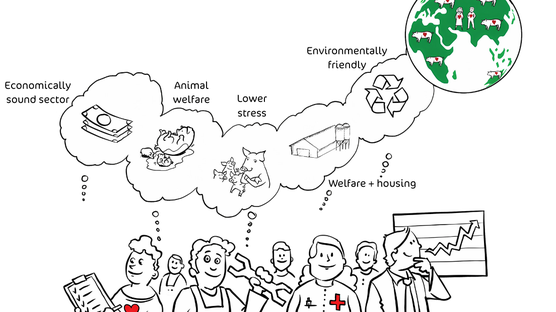
Published on Aug. 30, 2023
“Genetics, feed, and farmer must be a good match”: A Hypor customer success story
In Hooglede, Belgium, Johan Kino keeps about 260 sows in a semi-closed operation. He aims for optimal results at low costs, with as little extra work as possible. In cooperation with his Hypor advisor, feed consultant, and veterinarian, he has managed to boost results significantly in recent years. The secret: a feed formulation that exactly matches the sow's genetics.
This article was previously published in Varkensbedrijf.be. It has been edited and republished here with permission.
Johan Kino's sow farm is located in Hooglede, West Flanders, Belgium and runs his farm with 260 sows. Initially, all piglets went to an external finisher farm, but since 2006, Kino has been fattening half the piglets himself in contract farming at a second location. The pig farmer uses Hypor Libra PS sows and is currently using a Belgian Piètrain as the terminal boar. "With this combination, I am producing beautiful meat pigs," is the sow farmer's experience. He is very pleased with the Hypor genetics.

The Hypor Libra is an easy sow. Gestation goes well, AI goes well and farrowing also goes without problems. The advice from the Hypor representative gives real added value on my farm.
Five-week system provides structure
Johan weans the piglets at 28 days and operates a five-week system. For this purpose, the sows are divided into four groups of sixty sows. The sow replacement rate is 38.5 percent. Every five weeks, Kino receives a batch of ten SPF gilts at a weight of 125 to 130 kilograms. These first go five weeks in the quarantine pen where they are further vaccinated and then five weeks in another room where the heat is synchronized and the gilts are inseminated. After these five weeks, they go into the group. By then they weigh 160 to 170 kilograms. "I like the five-week system very much, although I do have busy weeks at times. In the farrowing week I am busy for three days. But everything comes together well."
Adjustment in feed
In 2019, Johan started working with Farm Nutrition consulting. This independent feed consultant makes customized feed formulations and ensures that the feeds are delivered in the right formula by Kino's feed supplier. Both the gestation and lactation feed for the sows and the weaning feed and phase 1 and 2 for the piglets are formulated and delivered in this way. "The advantage of this cooperation is that a feed is made that exactly matches the genetics of the Hypor Libra sow,” says Kino. "This way the genetic capacity is fully utilized. And that has an effect. Since we have been feeding this way, the results have improved year after year."

From twelve to fourteen delivered piglets per litter in three years
To show the progress, Kino looks at the most recent technical results and the 2020 results. One of the first things that stands out is the difference in the number of piglets sold per litter. While the litter size was 12 in 2020, it is now an average of 13.95. And more growth is expected. "From the last group of sixty sows, I delivered a total of 844 piglets at 25 kilograms. That's over fourteen per sow," says Kino. Per litter, 16.3 are born, of which 15.1 are alive. Of these, 14.02 are weaned. The litter index is 2.45. While these are nice numbers, Kino continues to set the bar high. "The goal now is to sell 35 piglets per sow annually. At the current rate, that is possible," he states.
Technical results per litter
| Total born: | 16.3 |
| Born alive: | 15.1 |
| Weaned: | 14.02 |
More uniformity, healthier piglets
To see further improvement, Kino is now considering the purchase of a cup system for supplementing milk in the farrowing pens. The mortality rate in the farrowing pen is currently at 9.3 percent. The pig farmer sees the cup system as a good tool to raise even more piglets born alive as quality piglets with less work. "Right now, I give milk four times a day and later add a pre-shake. Within the group, I shift smaller piglets to the best sows where necessary. In doing so, I make sure that piglets are already well accustomed to solid food in the farrowing pen. That way they start well in the piglet battery. There I have a low mortality rate of one percent. The piglets are healthy and put on good weight; the basis for a good start as a meat pig."
Results in livability
| Piglet mortality (farrowing barn) | 9.3 percent |
| Piglet mortality in the piglet farm | 1 percent |
| The sow replacement rate | 38.5 percent |
Collaboration adds value
Kino is very happy with the cooperation between the consultants from the different firms for his business. "It's good to have someone on the outside thinking with you. On your own, you often think everything is going well. But an outsider always sees things you don't see yourself. It is extra nice that these consultants work together to give good advice. Together with the veterinarian, the feed consultant and the Hypor consultant, we periodically walk through the barn and see what can be done differently. For example, we discuss different strategies. The idea for the cup system was discovered this way. Together we look at how we can produce as many healthy piglets as possible with as little labor as possible. It’s a nice collaboration. Genetics, feed and farmer must be a good match."



